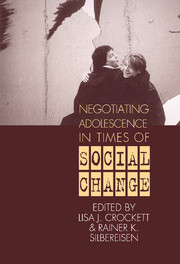Book contents
- Frontmatter
- Contents
- Contributors
- Preface
- 1 Social Change and Adolescent Development: Issues and Challenges
- Part I Models of Social Change Effects
- Part II Social Change and Adolescent Transitions
- Part III Social Change and Adolescents' Social Contexts
- Part IV Implications of Social Change for Adolescent Health and Well-Being
- Part V Interventions: Promoting Healthy Development in Times of Social Change
- 16 Research, Intervention, and Social Change: Improving Adolescents' Career Opportunities
- 17 Preparing Adolescents for Social Change: Designing Generic Social Interventions
- 18 Adolescents in the 21st Century: Preparing for an Uncertain Future
- Endnotes
- Index
16 - Research, Intervention, and Social Change: Improving Adolescents' Career Opportunities
Published online by Cambridge University Press: 26 January 2010
- Frontmatter
- Contents
- Contributors
- Preface
- 1 Social Change and Adolescent Development: Issues and Challenges
- Part I Models of Social Change Effects
- Part II Social Change and Adolescent Transitions
- Part III Social Change and Adolescents' Social Contexts
- Part IV Implications of Social Change for Adolescent Health and Well-Being
- Part V Interventions: Promoting Healthy Development in Times of Social Change
- 16 Research, Intervention, and Social Change: Improving Adolescents' Career Opportunities
- 17 Preparing Adolescents for Social Change: Designing Generic Social Interventions
- 18 Adolescents in the 21st Century: Preparing for an Uncertain Future
- Endnotes
- Index
Summary
Adolescents are peculiarly sensitive to social change. Their attitudes and beliefs are more labile than those of adults. Furthermore, they may carry into adult life the stamp of events that transpired as they were forming attitudes and making life choices and ideological commitments (Elder, 1974).
Adults who try to intervene on behalf of adolescents confronted by social change never know for sure what changes will actually occur, what their consequences will be, and what intervention might ameliorate their negative consequences. Social science research can reduce but never eliminate these uncertainties. The following are three contributions research can make to interventions to help adolescents cope with social change, provided that the change is slow enough:
Research can serve as an early warning system, identifying changes that might not otherwise be visible and, ideally, identifying their sources as well.
Research can discover responses, for example, by comparing the incidence and consequences of changes – historically, cross-nationally, and in different locations – and drawing attention to desirable conditions or effective interventions.
Research can test interventions to help shape them and determine their effectiveness.
Social change is too vast, inchoate, and protean to be grasped at once. However, like a fishing net, once it is grasped by a single knot, everything proves to be connected, however tangled and unmanageable the whole. We will take hold of one knot in the net of social changes affecting contemporary adolescents in the United States, treating it as a useful starting point that necessarily leads to other changes. That knot is the constricted employment prospects of young people who have not graduated from college.
- Type
- Chapter
- Information
- Negotiating Adolescence in Times of Social Change , pp. 267 - 283Publisher: Cambridge University PressPrint publication year: 1999



